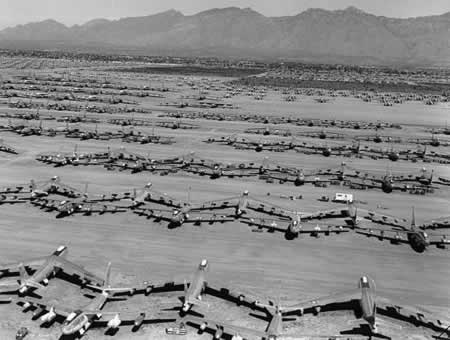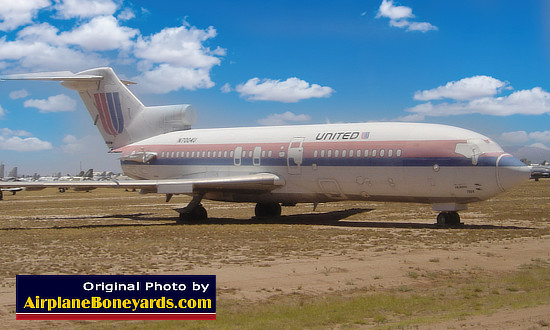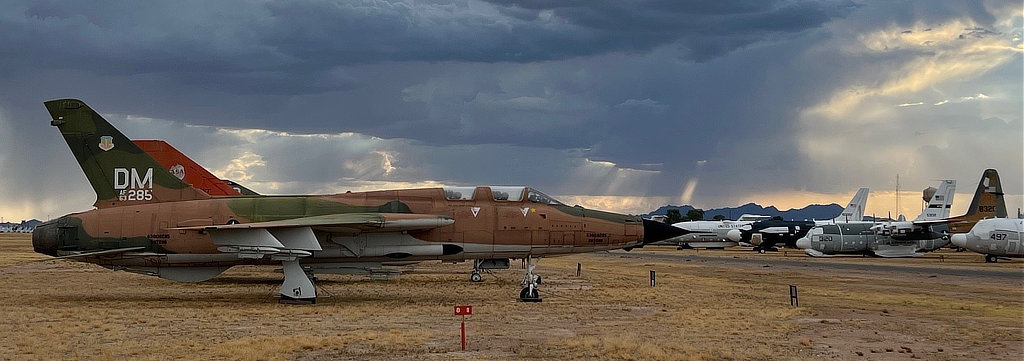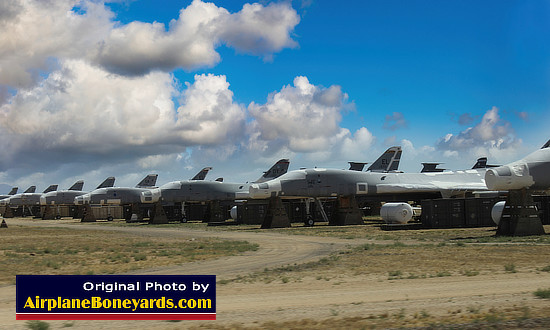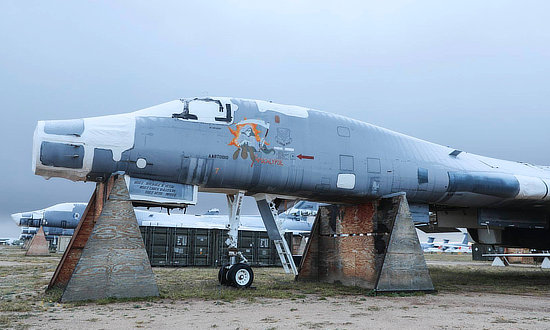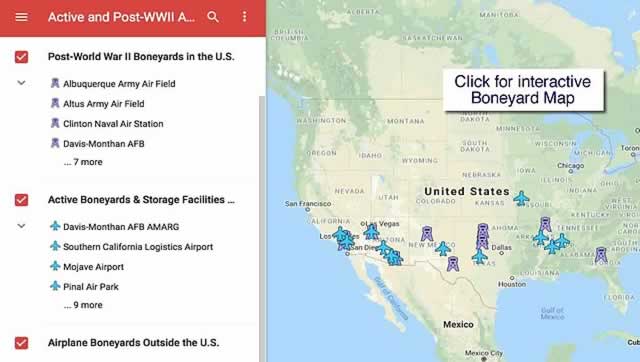
Davis-Monthan Air Force Boneyard in Tucson: Layout, Operations, Tours, and Maps
Davis-Monthan & AMARG's Role as the Largest Military Aircraft Boneyard
Davis-Monthan Air Force Base's role in the storage of military aircraft began after World War II, and continues today.
It has evolved into "the largest aircraft boneyard in the world".
With the area's low humidity in the 10%-20% range, meager rainfall of 11" annually, hard alkaline soil, and high altitude of 2,550 feet allowing the aircraft to be naturally preserved for cannibalization or possible reuse, Davis-Monthan is the logical choice for a major storage facility.
The geology of the desert allows aircraft to be moved around without having to pave the storage areas.
By May of 1946, more than 600 B-29 Superfortresses and 200 C-47 Skytrains had been moved to Davis-Monthan.
In addition, about 30 other aircraft were stored at Davis-Monthan that were destined for museums, including the "Enola Gay" and "Bockscar".
 Stacks of Republic F-84F Thunderstreaks at Davis-Monthan AFB awaiting scrapping in November, 1958 |
In 1965, the Department of Defense decided to close its Litchfield Park storage facility in Phoenix, and consolidate the Navy's surplus air fleet into Davis-Monthan.
Along with this move, the name of the 2704th Air Force Storage and Disposition Group was changed to Military Aircraft Storage and Disposition Center (MASDC) to better reflect its joint services mission.
In early 1965, aircraft from Litchfield Park began the move from Phoenix to Tucson, mostly moved by truck, a cheaper alternative than removing planes from their protective coverings, flying them, and protecting them again.
In 1985, the facility's name was changed again, from MASDC to the Aerospace Maintenance and Regeneration Center (AMARC) as outdated ICBM missiles also entered storage at Davis-Monthan.
By May of 1946, more than 600 B-29 Superfortresses and 200 C-47 Skytrains had been moved to Davis-Monthan. Some were preserved and returned to action in the Korean War, others were scrapped.
Aerial view of Davis-Monthan Army Air Field, May 1946,
showing more than 600 B-29 Superfortress and 200 C-47 aircraft in storage |
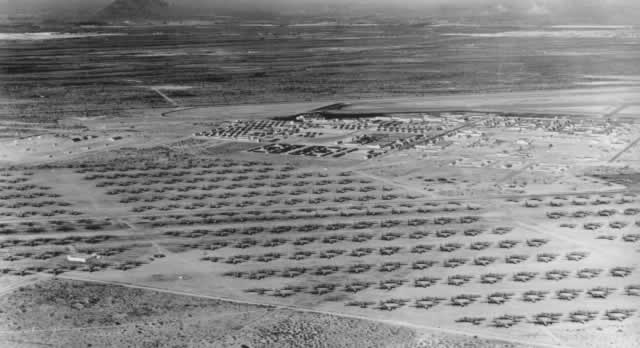 |
B-29 Superfortress Storage Post-WWII
With the end of World War II and victory over Japan and Germany assured, the United States found itself with a large inventory of aircraft, numbering about 65,000. These were temporarily stored and subsequently disposed of at 30 airfields, with the largest concentrations at seven major depots such as Kingman Army Airfield in Arizona and Walnut Ridge Army Air Field in Arkansas.
While some planes went into civilian usage, most were scrapped and their metal components melted and sold. Other planes were kept for future usage, and stored at several locations, including Warner-Robins, Victorville, Pyote Army Air Field in Texas, and Davis-Monthan AAF.
Immediately after the war, the Army's San Antonio Air Technical Service Command established a storage facility primarily for B-29 Superfortress and C-47 Skytrain aircraft at Davis-Monthan.
Many of the B-29s would be pressed back into service as the Korean War escalated in the early 1950s, and would see service again as bombers, KB-29 aerial tankers and weather reconnaissance.
Rows of cocooned Boeing B-29 Superfortress bombers in storage at Davis-Monthan Air Force Base, circa 1950 |
 |
Boeing B-29 "Enola Gay" in storage at Davis-Monthan AFB post-WWII Now on display at the Udvar-Hazy Smithsonian Museum in Washington, D.C. |
 |
Boeing B-29 "Bockscar" in storage at Davis-Monthan AFB after World War II Now on display at the National Museum of the United States Air Force in Dayton, Ohio |
 |
The End of the B-36 Peacemaker Fleet
Aerial view of Convair B-36 Peacemakers at Davis-Monthan AFB awaiting scrapping The last Peacemaker was scrapped on July 25, 1961 |
 |
 End of the line: ground view of B-36 Peacemakers at Davis-Monthan AFB in 1958 |
In February of 1956, the first Convair B-36 Peacemaker aircraft arrived at Davis-Monthan AFB for scrapping.
All of the fleet of 384 Peacemakers would ultimately be dismantled except for four remaining B-36 survivors saved for air museums.
Scrapping of the B-47 Stratojet Fleet
The last Air Force B-47 Stratojet bomber was retired at the end of 1969, and the entire fleet of 2,042 was dismantled at Davis-Monthan except for about 30 Stratojets which were saved for display in air museums.
Aerial view of dozens of Boeing B-47 Stratojets at Davis-Monthan AFB awaiting scrapping in January, 1967 |
Stacks of metal ingots from melted Boeing B-47 Stratojets at Davis-Monthan in April, 1962.
B-47B S/N 51-2284 rests in the background, awaiting its turn at the smelter, with 51-2321 seen in the left of photo. (USAF Photo) |
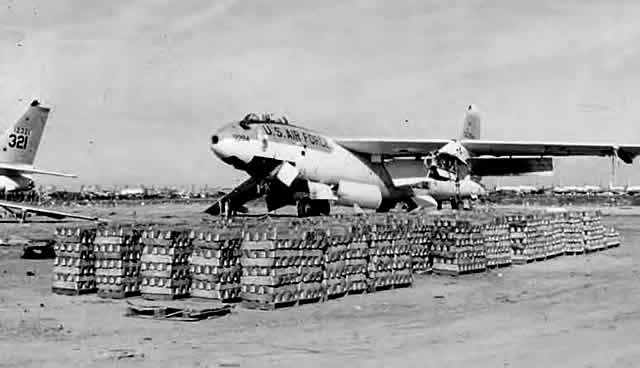 |
Today: Aerospace Maintenance and Regeneration Group (AMARG) - Home of the World's Largest Airplane Boneyard
Davis-Monthan AFB is today the location of the 309th Aerospace Maintenance and Regeneration Group (AMARG), the sole aircraft boneyard and parts reclamation facility for all excess military and government aircraft.
Aircraft from the Air Force, Navy, Marine Corps, Coast Guard, NASA and other government agencies are processed at AMARG, which employs 550 people, almost all civilians. It is the largest airplane boneyard in the world.
Another role of AMARG is to support the program that converts old fighter jets, such as the F-4 Phantom II and F-16, into aerial target drones.
It also serves as an auxiliary facility of the National Museum of the United States Air Force, and stores tooling for out-of-production military aircraft.
AMARG's typical inventory comprises more than 4,400 aircraft, which makes it the largest aircraft storage and preservation facility in the world.
The Air Force Materiel Command's 309th Aerospace Maintenance and Regeneration Group (AMARG) is organized as follows:
- 576th Aerospace Maintenance and Regeneration Squadron
- 577th Commodities Reclamation Squadron
- 578th Storage and Disposal Squadron
- 309th Support Squadron
AMARG Aircraft In-Processing Procedures
When aircraft arrive at the AMARG, they are by the "receiving branch". Each aircraft brings along its entire history of documentation, including maintenance actions over its years of service.
 Aerial view of Davis-Monthan Air Force Base and AMARG airplane boneyard in Tucson, Arizona with rows of C-141 Starlifters, B-1B Lancers and F-111 Aardvarks in storage |
All aircraft going into storage are processed as follows:
- All guns, ejection seat charges, and classified hardware are removed, along with clocks and data plates.
- Each aircraft is washed on arrival . The washing is especially important for aircraft that have served aboard aircraft carriers or in tropical locations where they were subject to the corrosive effects of warm, salty air.
- The fuel system is protected by draining it, refilling it with lightweight oil, and then draining it again, leaving a protective oil film.
- The aircraft is sealed from dust, sunlight, and high temperatures. This is done using a variety of materials, ranging from "spraylat" (a white, opaque, high-tech vinyl plastic compound sprayed on the aircraft) to simple garbage bags. With the white coating, interior temperatures will usually remain within 15 degrees of the outside ambient air temperature.
- The plane is towed by a tug to its designated "storage" position.
Aircraft Inventory Types Used by AMARG
 Aerial view of work areas at Davis-Monthan Air Force Base AMARG |
AMARG uses the following official "Type" categories for aircraft in storage:
- Type 1000 - aircraft at AMARG for long-term storage, to be maintained until recalled to active service. These aircraft are "inviolate" - have a high potential to return to flying status and no parts may be removed from them. These aircraft are “represerved” every four years.
- Type 1500 - aircraft previously fully preserved.
- Type 2000 - aircraft available for parts reclamation, as “aircraft storage bins” for parts, to keep other aircraft flying.
- Type 3000 - "flying hold" aircraft kept in near flyable condition in short-term, temporary storage; waiting for transfer to another unit, sale to another country, or reclassification to the other three types.
- Type 4000 - aircraft in excess of DoD needs - these have been gutted and every usable part has been reclaimed. They will be sold, broken down into scrap, smelted into ingots, and recycled.
AMARG Layout and Aircraft Storage Areas
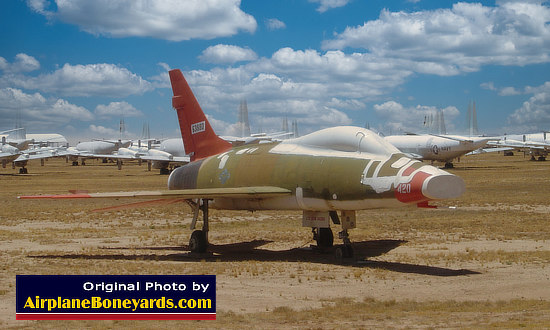 F-100 Super Sabre S/N 63880 on display on Celebrity Row at AMARG - Lt. Col. Gene Gaddis still painted on the fuselage (Staff Photo) |
Kolb Road runs north-south through the AMARG area, and is below ground level so viewing aircraft from this part of the road is really not possible from a moving vehicle.
The northern boundary of the area is East Escalante Road and East Irvington Road, while the southern boundary runs along East Valencia Road. See map below.
The area to the west of Kolb Road is used mainly for long-term storage, but also contains the arrivals ramp, maintenance shelters, wash racks, lubrication area, and preservation preparation.
Also on the west side is an area commonly called "Celebrity Row" or "History Row", a major stopping point on bus tours and includes representative aircraft of the type in storage at the time. The aircraft on display in this area will vary from time to time, and year to year.
 Reclaimed parts at Davis-Monthan's AMARG facility |
The area to the east is used to store aircraft which are in the process of being reclaimed for parts. In Fiscal Year 2012 AMARG "pulled" more than 10,000 parts, with a value of $472 million. In that year the five fleets calling for the most parts were the Air Force's F-15, B-1B, F-16, C-5, and C-135. The only Navy airplane on the top 10 list, the P-3 Orion, came in sixth.
Orders for spare parts are received by AMARG on a Form 44. It documents the requesting base/unit, its priority, whether it supports a combat mission, classification, special handling requirements, acceptable substitutions, and other information.
Aerial Map of Davis-Monthan Air Force Base, AMARG and the Pima Air & Space Museum
Map of the location of Davis-Monthan AFB, the AMARG boneyard areas,
and the nearby Pima Air Museum |
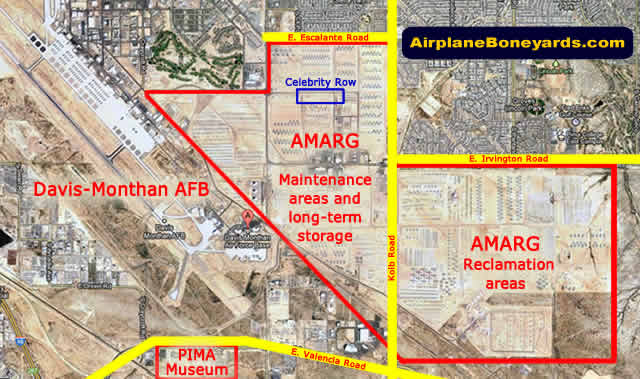 |
Boneyard Tours of the AMARG Facility
AMARG is a controlled-access facility and off-limits to personnel without the proper clearance.
AMARG Tour InformationIn the past, AMARG bus tours have originated at the nearby Pima Air and Space Museum, phone 520.574.0462 At the present time the tour has been indefinitely suspended by request of the U.S. Air Force. |
"Display Row" (or Celebrity Row) at AMARG
| In the photo below aircraft are seen on display at "Display Row" during the bus tour at Davis-Monthan's AMARG facility. Aircraft in this area are changed periodically. Today, the bus tours are not avaiable. (Staff Photo) |
 |
 F-14 on display on Display Row |
 A-10 Thunderbolt II on Display Row |
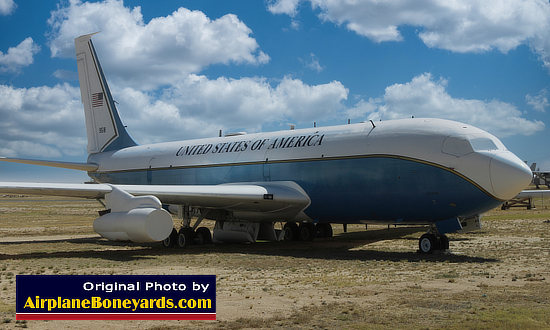 United States of America C-135K S/N 91518 at AMARG in Arizona |
 U.S. Air Force C-22A Transport, S/N 84-0193 ... variant of the Boeing 727 ... parked on Display Row |
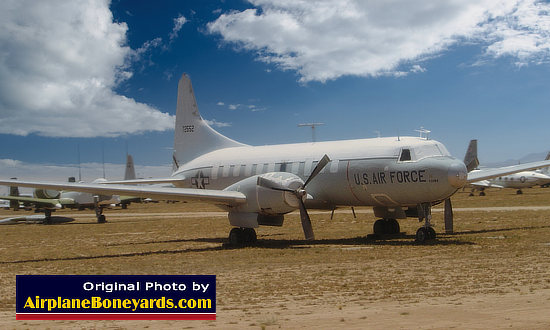 Convair C-131 Samaritan, S/N 72552, military version of the Convair 240, Display Row, AMARG |
|
|
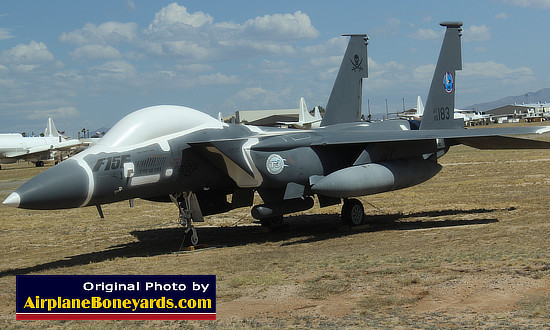 U.S. Air Force F-15E parked on Celebrity Row at AMARG |
 H2 Seasprite (L) and MH-53E Super Stallion (R) on Celebrity Row, AMARG |
B-52 Stratofortress Storage, Scrapping & Return to Active Duty
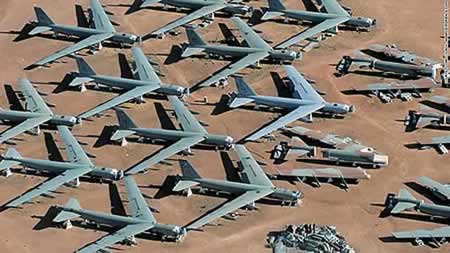 USAF Boeing B-52 Stratofortresses in storage at Davis-Monthan AFB |
Over the years, hundreds of surplus B-52 Stratofortress bombers have been dismantled at the facility, either due to obsolescence or as part of disarmament treaties.
Not all aircraft at the boneyard are scrapped. In the USAF photos below, B-52H Stratofortress "Ghost Rider" S/N 61-1007 is seen being restored back to flight status by AMARG boneyard personnel along with maintenance crews from Barksdale, Minot and Tinker Air Force Bases.
The Superfortress later flew to Barksdale AFB after 7 years of storage on February 17, 2015 at 23,000 feet at a speed of 250 knots with a crew of three.
Another B-52H, S/N 60-0034, "Wise Guy", was also restored and returned to active service in the Air Force in March of 2021. See photos below, courtesy of the 309th AMARG.
End of Active Service and Scrapping of the Convair B-58
Only 116 of the B-58 Hustlers were built, 30 trial aircraft and 86 production B-58A models, all at the Fort Worth Convair plant.
The Air Force began to retire their two B-58 Hustler wings in November of 1969, and the aircraft were moved to Davis-Monthan AFB for storage. The last one was retired from service in 1970.
The surviving fleet of 82 Hustlers remained in storage until 1977 when it was sold to Southwestern Alloys for scrapping.
C-5 Galaxy Storage and Scrapping
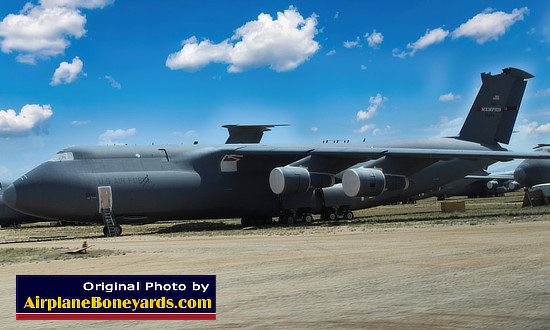 USAF C-5 Galaxy transport in storage at Davis-Monthan's AMARG facility |
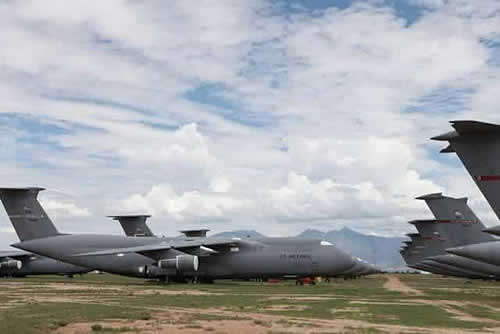 C-5A Galaxy transports in storage at Davis-Monthan AMARG (Photo by USAF 309th AMARG) |
 C-5A Galaxy reclamation at Davis-Monthan Air Force Base AMARG (Photo by USAF 309th AMARG) |
C-141 Starlifter Scrapping
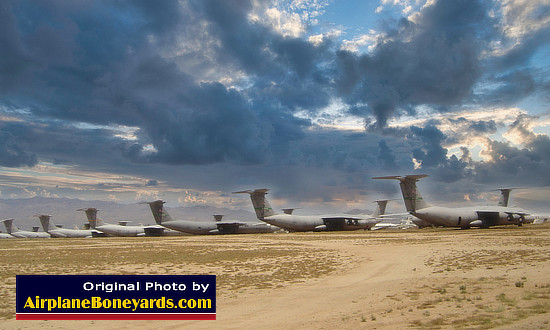 C-141 Starlifter cargo aircraft at Davis-Monthan AFB AMARG facility |
 C-141 Starlifter being recliamed - former AETC aircraft from Altus AFB, S/N 67946 |
Aerial view of C-141 and B-52 aircraft at Davis-Monthan Air Force Base AMARG boneyard |
 |
B-1B LancersOf the 100 B-1B Lancers that were built for the U.S. Air Force, about 45 remain in active service. Seen in the photo below are Lancer bombers in storage at Davis-Monthan's AMARG facility.
|
F-4 Phantom II Storage at AMARG
F-4 Phantom II fighters in desert storage at Tucson, Arizona, AMARG |
 |
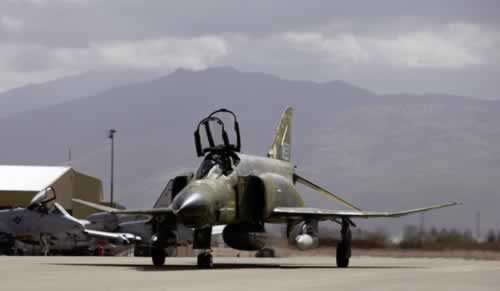 RF-4C Phantom tail number 68-0599 after regeneration at Davis-Monthan AMARG (Photo by the U.S. Air Force) |
The final F-4 regenerated from storage at the 309th Aerospace Maintenance and Regeneration Group performed its last flight over Tucson, Arizona on April 17, 2013, before flying to Mojave, California.
Tail number 68-0599, an RF-4C Phantom, arrived at AMARG for storage on January 18, 1989 and had not flown since. The jet's assigned call sign was "Last One."
AMARG's technicians re-installed hundreds of parts and performed thousands of hours of maintenance to return the fighter to flyable status. This aircraft represents the 316th F-4 withdrawn from storage in support of Air Combat Command's full-scale aerial target program. BAE Systems will convert the aircraft into a QRF-4C drone, and then deliver it to the 82nd Aerial Targets Squadron at Tyndall Air Force Base, Florida.
Not all aircraft at AMARG remain there, and many are returned to active military service, or transferred to museums or memorials. Here is a RF-4C Phantom being loaded for transport to the East Mississippi Veterans Foundation in Meridian, Mississippi, on June 6, 2022. (Photo by the 309th AMARG) |
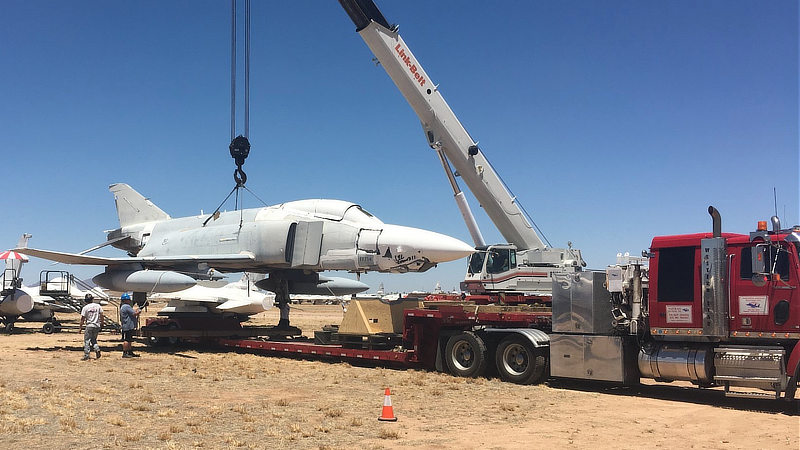 |
F-16 Storage at AMARG
 |
 |
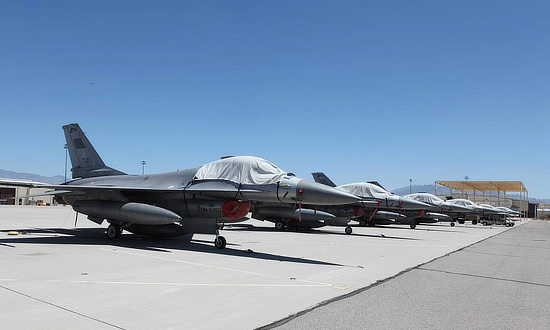 (Photo by 309th AMARG) |
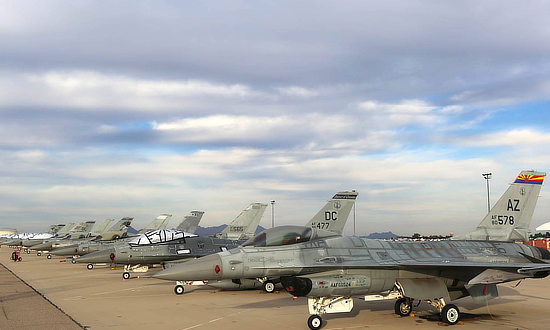 (Photo by 309th AMARG) |
A-10 Warthogs at AMARGA-10 Thunderbolts parked at the Davis-Monthan Air Force Base AMARG facility 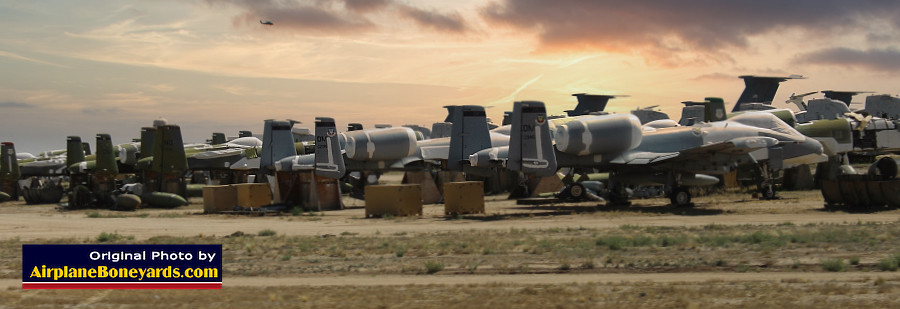
|
FB-111 Aardvark at AMARGThe USAF's F-111A first flew in December 1964, and the first production models were delivered to the USAF in 1967. In all, 566 F-111s of all series were built. Seen in this photo is FB-111A Aardvark, S/N 68-0249, in storage at AMARG (309th AMARG photo) 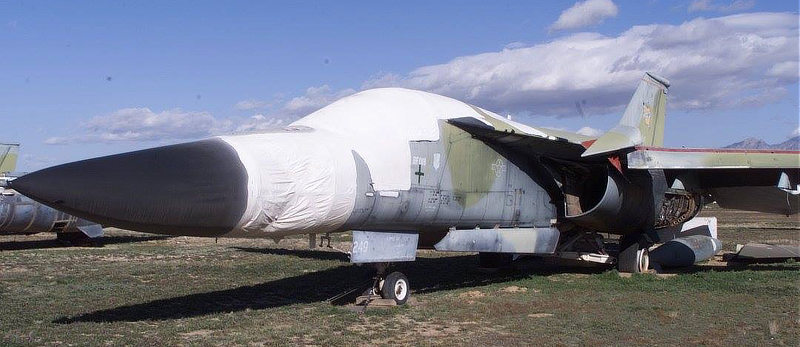 |
C-130 Hercules Storage
Looking over the fence at AMARG ... C-130 Hercules aircraft in storage |
 |
Aerial view of C-130 aircraft at the Davis-Monthan Air Force Base AMARG boneyard |
HC-130H7 Hercules 1700 of the U.S. Coast Guard, Barbers Point; originally ordered by the USAF as S/N 82-0081. Seen in this photo in storage at AMARG. (309th AMARG photo) 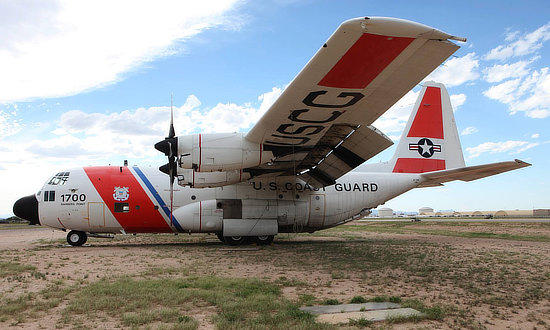 |
C-130H Hercules of the U.S. Air Force, S/N 78-0809, 911 AW, with nose art "We Have Not Forgotten", in storage at AMARG (309th AMARG photo) 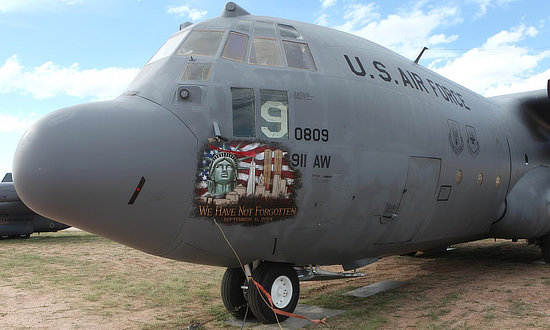 |
C-135 Storage and Reclamation at AMARG
| USAF KC-135 tankers in storage at Davis-Monthan's AMARG facility |
 |
C-135 aircraft in the parts reclamation area at AMARG  |
Reclamation of C-135s at AMARG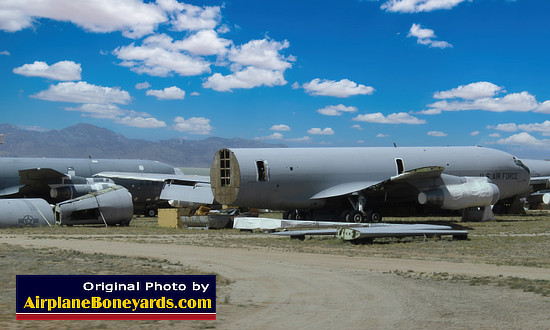 |
| Surplus Boeing 707 airliners were purchased by the Air Force from Trans World Airlines, American Airlines and other air carriers for use as parts for USAF C-135 aircraft. Shown in the photo below is a former Boeing 707-358B, C/N 20097, originally operated by El Al Israel Airlines as registration 4X-ATT, last registered as TF-AYF. |
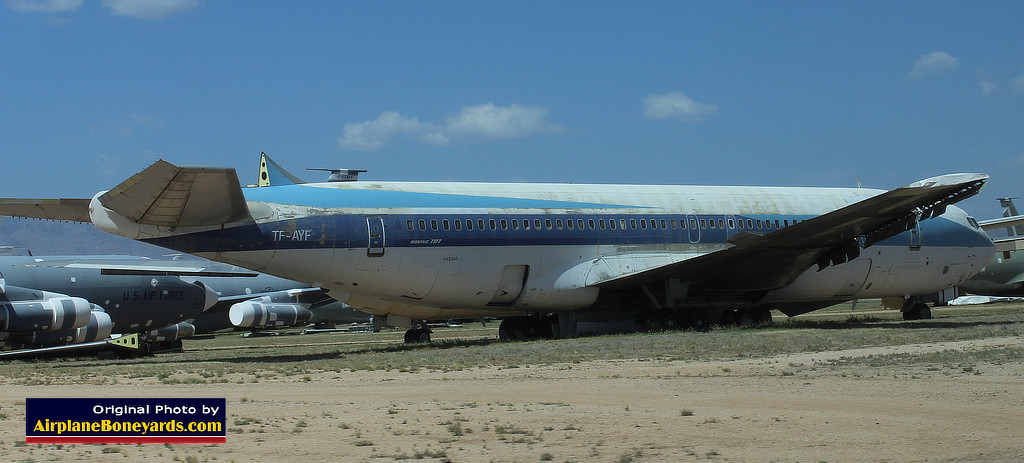 |
Recent News Related to AWACS Aircraft |
| 13th AWACS Jet Flies West to Boneyard, Last of 2023 Divestments Air & Space Forces Magazine - 10/11/2023 |
| E-3 Sentry (AWACS) #83-0009 took off from Tinker Air Force Base for the final time on September 21, 2023. Aircraft #83-0009 is now among over a dozen AWACS sent to the 309th Aerospace Maintenance and Regeneration Group (AMARG) in Tucson, Arizona for reduction. The AWACS fleet is down to just 18 aircraft with the retirement of the last of 13 aircraft to be divested from Tinker AFB this year. |
NATO E-3C AWACS aircraft LX-N 90449 being led to its designated parking area at AMARG. The aircraft was defueled before being towed into the storage area. June 23, 2015 (Photo by the 309th AMARG) |
 |
U.S. Air Force E-3C AWACS aircraft in storage at AMARG (Photo by the 309th AMARG) |
 |
KC-10 Extender Storage and Reclamation at AMARG
| The first USAF KC-10 Extender, S/N 86-0036, from McQuire Air Force Base, destined for storage arrives at AMARG on July 13, 2020 (Photo by USAF 309th AMARG) |
 |
| KC-10 Extenders at AMARG in storage and reclamation (Photo by USAF 309th AMARG) |
 |
F/A-18 Hornet Storage at AMARG
 F/A-18A Hornet, BuNo 162442, VMFA 314 (Photo by 309th AMARG) |
 F/A-18A Hornet, BuNo 163151 from VFA-204 Naval Air Station Joint Reserve Base New Orleans, LA (Photo by 309th AMARG) |
U.S. Navy P-3 Orions in Storage at AMARG
 U.S. Navy P-3C Orion BU 158206 arriving at AMARG from Whidbey Island, WA, October 1, 2013 (Photo by 309th AMARG) |
 U.S. Navy P-3C Orion BU 161412 (Photo by 309th AMARG) |
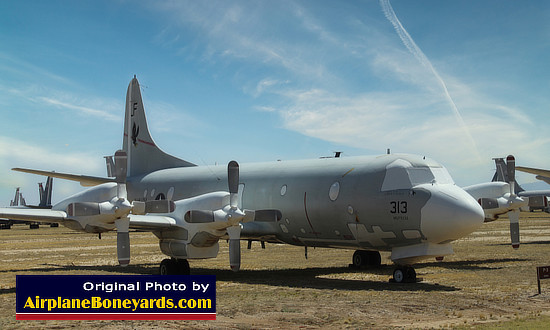 U.S. Navy P-3 Orion on AMARG Celebrity Row |
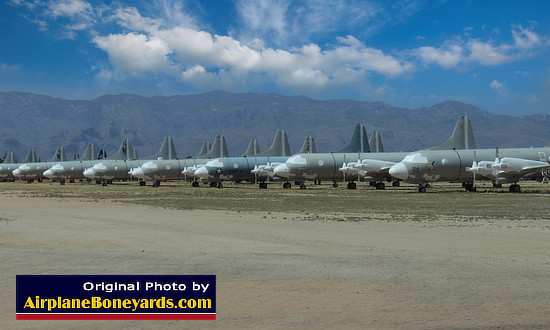 U.S. Navy P-3 Orions in storage at AMARG |
Other Aircraft in Storage at AMARG
 T-34C Turbo Mentors (Photo by 309th AMARG) |
 U.S. Navy MH-53E Sea Hawk (Photo by 309th AMARG) |
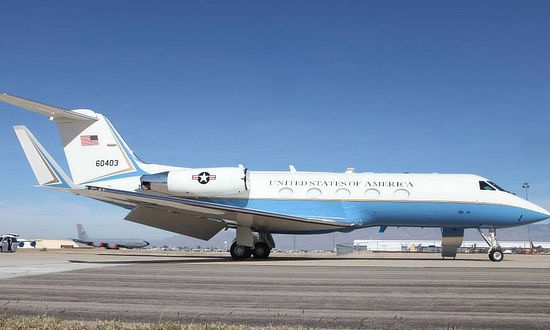 USAF C-20C, S/N 86-0403 (Photo by 309th AMARG) |
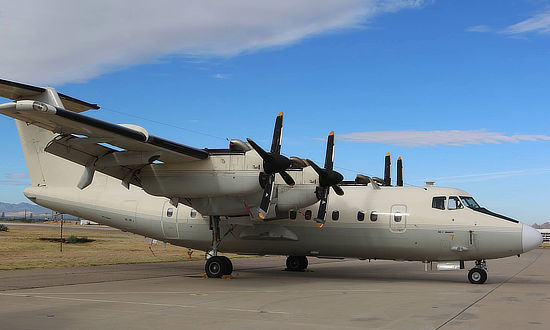 de Havilland Canada DHC-7 (Photo by 309th AMARG) |
C-97 and EC-121 Storage
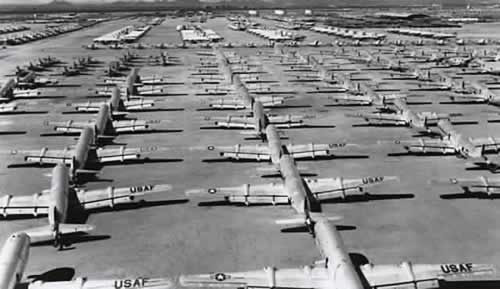 Rows of Boeing C-97 and KC-97 aircraft at Davis-Monthan AFB, circa early 1970s |
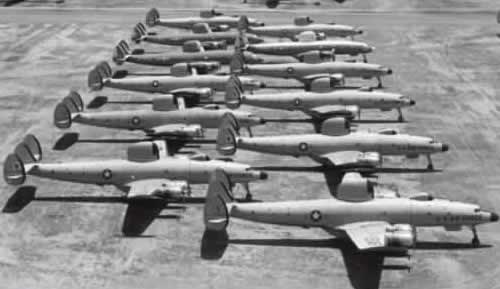 Lockheed C-121 and EC-121 Constellations at Davis-Monthan AFB in storage, early 1970s |
YouTube Video of Davis-Monthan AFB AMARG boneyard in Tucson, Arizona
Interactive Map of the Davis-Monthan Air Force Base Area in Tucson
Davis-Monthan Field ... the Early Years
The Tucson Chamber of Commerce established the nation's first municipally-owned airfield in 1919 in the dry, Arizona desert. In 1927 the airfield was moved to a site southeast of town and dedicated as Davis-Monthan Landing Field, then the largest municipal airport in the United States.
The airport was named in honor of Lieutenants Samuel H. Davis and Oscar Monthan, two WWI pilots, and both Tucson natives, who died in military aircraft accidents.
Davis-Monthan Army Air Field During World War II
Davis-Monthan Airport became Tucson Army Air Field in 1940, and was renamed Davis-Monthan Army Air Field on December 3, 1941, just prior to the Japanese attack on Pearl Harbor.
The outbreak of World War II brought major changes to Davis-Monthan, with units of the 1st Bombardment Wing and 41st Bombardment Group (BG) departing for the Pacific theater. In January of 1942 jurisdiction of the field transferred from the 4th Air Force to 2nd Air Force. The following month the 39th BG arrived and began training B-17 Flying Fortress and B-24 Liberator units and crews. By mid-1942 B-24 Liberator training became the sole mission of the 39th BG, with all other flight training phased out. In December of 1944 Davis-Monthan became home to the B-29 Superfortress.
Training at the airfield came to a halt in August 1945, when the Japanese unconditionally surrendered. Davis-Monthan also played a post-war role by housing German POWs from June 1945 to March 1946.
Davis-Monthan AFB: Post-WWII and the Cold War
Davis-Monthan's Post-WWII inactivity quickly ended in March of 1946 when the newly activated Strategic Air Command (SAC) assumed control of the base. Two months later two B-29 Bombardment Groups, the 40th and 444th, arrived and once again the B-29 Superfortress became a key element in base operations.
On January 13, 1948 Davis-Monthan Army Air Field was officially redesignated Davis-Monthan Air Force Base.
 Entrance gate to Davis-Monthan Air Force Base, Home of the 36th Air Division, as seen in this historic postcard |
The following month on February 20, 1948, the first B-50 Superfortress arrived and was delivered to the 43 BW. On June 18, the 43rd Air Refueling Squadron (ARS) was assigned to the base and had the honor of being one of the first two air refueling squadrons in the U.S. Air Force, flying the KB-29M tanker.
In February of 1953 the 303rd BW received four Lockheed T-33 Shooting Stars training jets. At the same time, construction on a new 11,500 feet runway was completed in preparation for the arrival of the first jet bomber, the B-47 Stratojet.
F-86A Sabre and F-86D Sabre Dog aircraft remained the squadron's primary weapon systems until 1959 when the F-89 Scorpion was added to the arsenal. Another aircraft change occurred in 1960 when the F-101B Voodoo became the units' interceptor.
On October 15, 1959, the Air Force Ballistic Missile Committee approved Davis-Monthan as the first Titan II base, and in the early 1960s the base was selected to become home to an Intercontinental Ballistic Missile (ICBM) wing.
In 1964, the last B-47 departed Davis-Monthan, making way for the arrival of nearly 50 F-4 Phantom II aircraft. A new mission was to train all aircrews for the conversion of 12 tactical wings to the F-4C fighter-bomber jet. The 4453 CCTW trained a majority of F-4 crews for the conflict in Southeast Asia.
On July 1, 1971 the Air Force reactivated the 355th Tactical Fighter Wing (TFW) at Davis-Monthan with the Vought A-7D Corsair II as the primary weapon system. In early 1975, the 355 TFW prepared for conversion to the Fairchild Republic A-10 Thunderbolt II - Warthog.
Davis-Monthan Today
|
Today, Davis-Monthan Air Force Base is home to 11,000 airmen from 34 mission partners, which support six combatant commanders around the globe. Over the years the base has earned a proud history of distinction, and most recently was awarded the 2018 Commander-in-Chief's award as the best base in the U.S. Air Force.
The host unit at Davis–Monthan remains the 355th Wing assigned to the Twelfth Air Force, which is headquartered at the base as part of Air Combat Command (ACC). Located at the base:
- 12th Air Force
- 309th AMARG
- 55th Electronic Combat Group
- 214th Attack Group of the Arizona National Guard
- 943rd Rescue Group of the Air Force Reserve
- U.S. Customs and Border Protection
The 355th is responsible for training and deploying A-10C Thunderbolt II pilots. The base's active aircraft inventory includes 84 A-10Cs, 15 EC-130H Compass Calls, 7 HC-130J Combat Kings, 15 HH-60G Pavehawks, and a contingent of F-16 Fighting Falcons.
More About Davis-Monthan AFB and the Pima Air & Space Museum
Official website of Davis-Monthan Air Force Base
Official website of the 309th AMARG
Volare Helicopters - aerial helicopter tours in Tucson including flights over AMARG
Tucson Travel Information from TripAdvisor |
Aircraft Scrapping Companies Located Near Davis-Monthan
Once a military plane is stripped of parts, the remains are put up for bid to private scrap dealers. Many of these are located close by Davis-Monthan, including Allied Aircraft, United Aeronautical Corporation, Minden Air Corporation, the Wiggins Group, Southwestern Alloys and others.
In earlier years, such companies would receive aircraft mostly intact; today, they are shredded/crushed before being provided to the scrapping companies.
 |
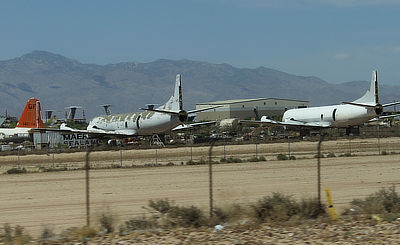 |
 |
Current AMARG Inventory
Two privately-operated, unofficial websites monitor the inventory at AMARG, using Freedom of Information listings published monthly by the 309th AMARG. The AirplaneBoneyards.com website has no connection with either of these other websites or the content they present; we just know of their existence.
AMARC Experience - Extensive information on the boneyard, and includes a searchable database by Serial/BuNo as well as listings by aircraft manufacturer.
GMAP.nl - Overview of current AMARG inventory, arrivals and removals.
Map of locations of active and post-WWII airplane boneyards and plane storage facilities in the United States
 |
||
 |
 |
 |
